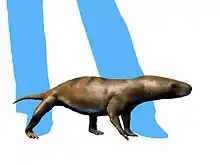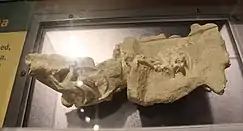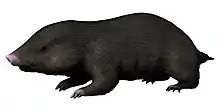| Chiniquodon Temporal range: Carnian ~ | |
|---|---|
 | |
| Fossil of C. theotonicus in the Museum of Paleontology, Tuebingen | |
| Scientific classification | |
| Domain: | Eukaryota |
| Kingdom: | Animalia |
| Phylum: | Chordata |
| Clade: | Synapsida |
| Clade: | Therapsida |
| Clade: | Cynodontia |
| Family: | †Chiniquodontidae |
| Genus: | †Chiniquodon von Huene 1936 |
| Type species | |
| †Chiniquodon theotonicus | |
| Species | |
| |
| Synonyms | |
| |

Chiniquodon is an extinct genus of carnivorous cynodonts, which lived during the Late Triassic (Carnian) in South America (Argentina and Brazil) and Africa (Namibia and Madagascar). Chiniquodon was closely related to the genus Aleodon,[1] and close to the ancestry of mammals.
Other contemporaries included early dinosaurs. As both groups filled a similar ecological niche, fairly large therapsid hunters such as Chiniquodon may have been outcompeted by dinosaurs.
Classification
Chiniquodon theotonicus, the type species, is from the Santa Maria Formation, Brazil and Chañares Formation, Ischigualasto-Villa Unión Basin, northwestern Argentina. This species is known from a number of skulls. The holotype is in the paleontological collection at Tübingen University, Germany.
Chiniquodon kitchingi, from the Santa Maria Formation of Brazil, was described in 1982 by A. M. Sá-Teixeira based on a single skull missing the lower jaw. When first described, it was assigned to the genus Probelesodon, but was reassigned to Chiniquodon in a 1995 paper by Fernando Abdala, as the type species of Probelesodon (P. lewisi) was found to be a junior synonym of C. theotonicus.[2] A 2002 paper by Abdala and Norberto P. Giannini went even further by synonymising C. kitchingi with C. theotonicus.[2] In 2023 the type material of C. kitchingi was redescribed by Hoffmann et al., who found it to be a valid species of Chiniquodon.[3]
Chiniquodon sanjuanensis[4] is from the Cancha de Bochas Member of the Ischigualasto Formation, Ischigualasto-Villa Unión Basin, northwestern Argentina. It was originally assigned to the genus Probelesodon, but was reassigned to Chiniquodon in 2002.[2] It is differentiated from C. theotonicus because of its teeth and the shape of the zygomatic process.

Chiniquodon kalanoro[5] is from the Isalo II Formation, Madagascar. This species is known from a mandible (holotype UA 10607).
Chiniquodon omaruruensis[6] is from the Omingonde Formation of Namibia. It is known from a single specimen (GSN F315), consisting of a complete skull and parts of the postcranial skeleton.
References
- ↑ Martinelli, A. G.; Kammerer, C. F.; Melo, T. P.; Paes Neto, V. D.; Ribeiro, A. M.; Da-Rosa, Á. A. S.; Schultz, C. L.; Soares, M. B. (2017). "The African cynodont Aleodon (Cynodontia, Probainognathia) in the Triassic of southern Brazil and its biostratigraphic significance". PLOS ONE. 12 (6): e0177948. Bibcode:2017PLoSO..1277948M. doi:10.1371/journal.pone.0177948. PMC 5470689. PMID 28614355.
- 1 2 3 Abdala, F.; Giannini, N. P. (2002). "Chiniquodontid cynodonts: systematic and morphometric considerations". Palaeontology. 45 (6): 1151–1170. doi:10.1111/1475-4983.00280.
- ↑ Hoffmann, C. A.; de Andrade, M. B.; Martinelli, A. G. (2023). "Anatomy of the holotype of 'Probelesodon' kitchingi revisited, a chiniquodontid cynodont (Synapsida, Probainognathia) from the early Late Triassic of southern Brazil". Journal of Paleontology: 1–18. doi:10.1017/jpa.2023.25.
- ↑ Ricardo N. Martinez & Catherine A. Forster (June 1996). "The skull of Probelesodon sanjuanensis, sp. nov., from the Late Triassic Ischigualasto Formation of Argentina". Journal of Vertebrate Paleontology. 16 (2): 285–291. doi:10.1080/02724634.1996.10011315.
- ↑ Christian F. Kammerer; John J. Flynn; Lovasoa Ranivoharimanana; André R. Wyss (2010). "The first record of a probainognathian (Cynodontia: Chiniquodontidae) from the Triassic of Madagascar". Journal of Vertebrate Paleontology. 30 (6): 1889–1894. doi:10.1080/02724634.2010.520784. S2CID 85868922.
- ↑ Mocke, H. B.; Gaetano, L. C.; Abdala, F. (2020). "A new species of the carnivorous cynodont Chiniquodon (Cynodontia, Chiniquodontidae) from the Namibian Triassic". Journal of Vertebrate Paleontology. 39 (6): e1754231. doi:10.1080/02724634.2019.1754231. S2CID 220548365.
Further reading
- Von Huene. Die Fossilien Reptilien des südamerikanischen Gondwanalandes an der Zeitenwende (Denwa-Molteno-Unterkeuper = Ober-Karnisch). Ergebnisse der Sauriergrabungen in Südbrasilien 1928/29. (The fossil reptiles of South American Gondwana during the temporal transition) (Denwa-Molteno-Upper Triassic = Upper Carnian). Results of the excavations in South Brazil 1928/29, part II.) 1936. Pages 93–159.





